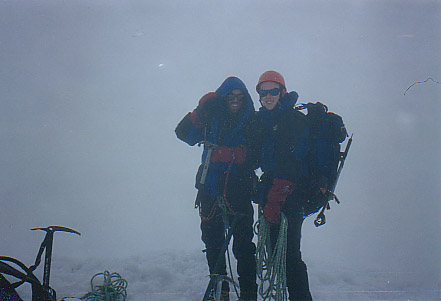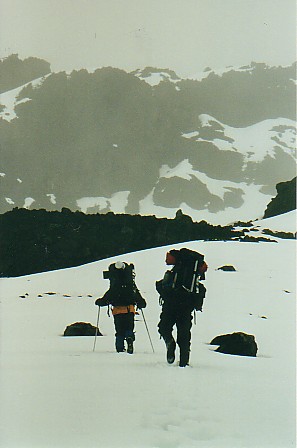On Saturday July 16, 2000 my cousin Nate, my friend Russ and I climbed the direct route of Iliniza Sur in Ecuador. On the way down, we started an avalanche and fell 1000ft. These are my recollections:

Just below the ridge, I sat down for a moment to rest in the deep, wet snow. I was tired, and glad to be on the descent. Following our green rope through the fog, I could see Nate also sitting in the snow below me and to the left. Further down, Russ had already scrambled over a small cornice and dropped into the top of a steeper snow chute, his head and shoulders dimly visible above the wall of snow.
Nate and I watched, waiting for Russís indication that this might be a way back to the refuge. We inched ourselves downward as we sat. A few pieces of rolling, sliding snow that Nate dislodged seemed harmless at first. But instead of slowing and dissipating, they swelled together over the edge toward Russ. With a jolt of adrenaline, I realized if that snow knocked Russ down, we might all fall. We were tied together but without fixed anchors. Whirling around, I plunged my ice axe and the tips of my crampons as deep as I could into the soft snow. I held my breath.
***

Iliniza Sur was supposed to be a consolation climb. Our ambitious goal had been the El Obispo summit of El Altar. That trip involved a two-day approach hike to a high camp at 15,200 feet. The mountain afforded us several breathtaking glimpses of the summit and the crater, but nothing more. For three nights wind and sleet buffeted our tent while snow piled up outside. So the Bishop turned us away.
Our hike back to the tiny mountain community of Candelaria was a long slog through mud of discouraging depth. But after a day of rest, Nate and I were eager to climb on the last day before our flights out of Ecuador. So the 3 of us left Russís house at 2:00am on Saturday and drove as far as we could on the road to the refuge in the saddle between Illinizaís north and south peaks. When the 4-wheel drive could go no further, we parked and began to hike.
I was not happily digesting my previous nightís meal and unfortunately slowed my companions down considerably on the approach. Although a pre-dawn start is recommended, we arrived at the glacier after daybreak. At that point Nate was not feeling too well either and we debated if we should continue. Visibility was poor, but Russ knew the route well. Other than the fog, the conditions looked good so we pressed on. Once we were really climbing we all felt better.
The terrain was more technical than I had done before, involving sustained stretches of steep ice. We swung ice axes in both hands, and moved upward, often kicking the front points of our crampons into the ice for foot placements. At the trickiest sections just below the ridge, we managed some fixed belays. We climbed well, but the rope work took time and by noon we were still over an hour from the summit.
We debated again whether to continue or retreat. It was late and the snow was getting soft, maybe too soft. But we felt strong and were anxious for the summit. We reached the top of Iliniza Sur at about 1:30 in the afternoon. No exhilarating summit panorama, nothing but snow and the same fog I often see when I step out to grab the morning paper. Still we felt proud of what we had done. Now we just needed to get down.
I was a bit anxious about the technical difficulties we would face. We carried flukes and ice screws for the necessary repels so there shouldnít be a problem. And the difficult downclimbing would of course fall on Russ. But the snow was heavy and the fog seemed to weigh us down. Tied last to the rope, I followed the others mechanically, resting where I could. The difficulties began, as I said, just below the ridge as we turned to descend one of the chutes.
***
When the pull on the rope did come it was so sharp and violent that I donít remember it at all. I donít remember lurching backward, or falling head over heels. I donít remember my hands coming out of my mitts; the right perhaps remaining strapped as it was to my ice axe. I donít remember going over the first edge.
I was so disoriented, my next conscious thought was the sleepy, early morning terror of a falling dream. My stomach clenched in the first drop of a roller coaster. In my dream, I was vaguely aware of speed and the greyness of fog, snow and ice; and of passing between rocks.
Moments passed and I continued sliding. The deafening rushing sound, the cold, and the physical tossing and pounding finally forced on me the unhappy realization that I was not in a dream. There was real acceleration: like being dragged behind horses, like stepping on the gas when you want to slow down. Head first or feet first, I couldnít tell and it didnít seem to matter.
Then I was floating in air, spinning, falling. In those first moments of free fall I understood that I might die. I might land on rocks, or in a crevasse, or anywhere. But the simultaneous realization that I could do nothing brought a strange, inexplicable peacefulness.
Then I was sliding again, still very fast. But after a few more moments, not as fast. The world stopped spinning and came into focus. The slope was gentler now. I could make out the sky above and a rocky mass to my left. As I slowed, there was hope. I spread out my arms, grabbing for something, anything, dragging them on the snow, not feeling the ice scraping against my bare hands.
Finally I stopped. I took a breath. I sat up. Was I alive? There was a lot of blood on the snow around me. I moved my arms, then my legs. Everything seemed to work. Just a lot of cuts and bruises. Bewildered, I looked around. To my right and a little below Nate had just sat up from an axeless self-arrest, and was staring at me wide eyed. "Are you all right?" he asked.
I felt foggy and it was difficult to think. "Iím not sureÖ" I replied. And after a few moments, "What about you?"
"I think my ankle is broken."
Thatís going to be a problem, I thought. And then in a quick wave of panic, I realized Russ was nowhere to be seen. I reasoned slowly, with deliberate effort. Well, up there he was tied to the other end of our green rope. Probably he still is. The rope disappears over a hump, so maybe heís down there. I worried that he was badly hurt. At that moment, Russ poked his head up. He was tangled awkwardly in the rope, his shoulder hanging at an odd angle. But he said he was okay.
We had come to rest on the lower flank of the glacier in the midst of a mass of dispersed avalanche debris. For the moment unsure what to do next, we chatted nervously about our fall. Nate checked the altimeter on his GPS: 1000 feet lower than his last reading on the ridge. I was shivering from the cold. Russ somehow managed to recover both my mitts, which had apparently fallen with us. "Weíve got to go down!" he said.
A jumble of tangled rope, wet clothes, and various injuries, we began scuttling down the rest of the glacier. I couldnít put much weight on my right leg, and Nate couldnít put any on his right ankle, so we scooted forward as far as we could on our butts. What remained was fortunately a relatively gentle slope. No more worries about repels or steep sections. We had passed all that in a few terrifying seconds.
Eventually, we untied from the rope and put it away. When we reached edge of the glacier, Russ and I tried to support Nate on our shoulders, but that was too painful for all of us. Nate had to crawl on two hands and one foot. Actually, I couldnít move much faster than that anyway.
Now our main problem was finding the refuge. We knew we were pretty low on the mountain and thought it must be fairly close. But we didnít really know where we were, and we couldnít see more than a couple hundred feet, so it was impossible to reliably orient ourselves. We chose a line based on Russís mountain intuition. But soon Russ realized that to maximize our chances, he needed to move faster than Nate and I could. So he went ahead.
The GPS should have been more help than it was. But Nate was busy just trying to move along the ground. I hadnít used one before, and was in no condition to learn. When I could find them, the directional readings didnít seem to make sense. We didnít disregard them, but we didnít completely trust them either. Mainly we just crept forward, trying to follow Russís footprints. Nateís strategy was to keep our spirits up by telling remarkably bad jokes. I alternated between praying to God to rescue us, and cursing a blue streak from frustration, discomfort and fear.
After Russ had been gone for quite a long time I began to wonder if Nate and I would reach the refuge. It was still only mid-afternoon, but it seemed darker to me. I didnít know if we could last the night at that altitude in our wet clothes. Nate was more confident, but I felt very cold.
Suddenly over a rise and through the fog appeared three climbers. From the concern in their eyes, I could see that they were looking for us. Russ must have reached the refuge and sent help. The first one gently reached out his hand to me. "ŅEstás herido?" he asked. Then I knew we were going to be fine.